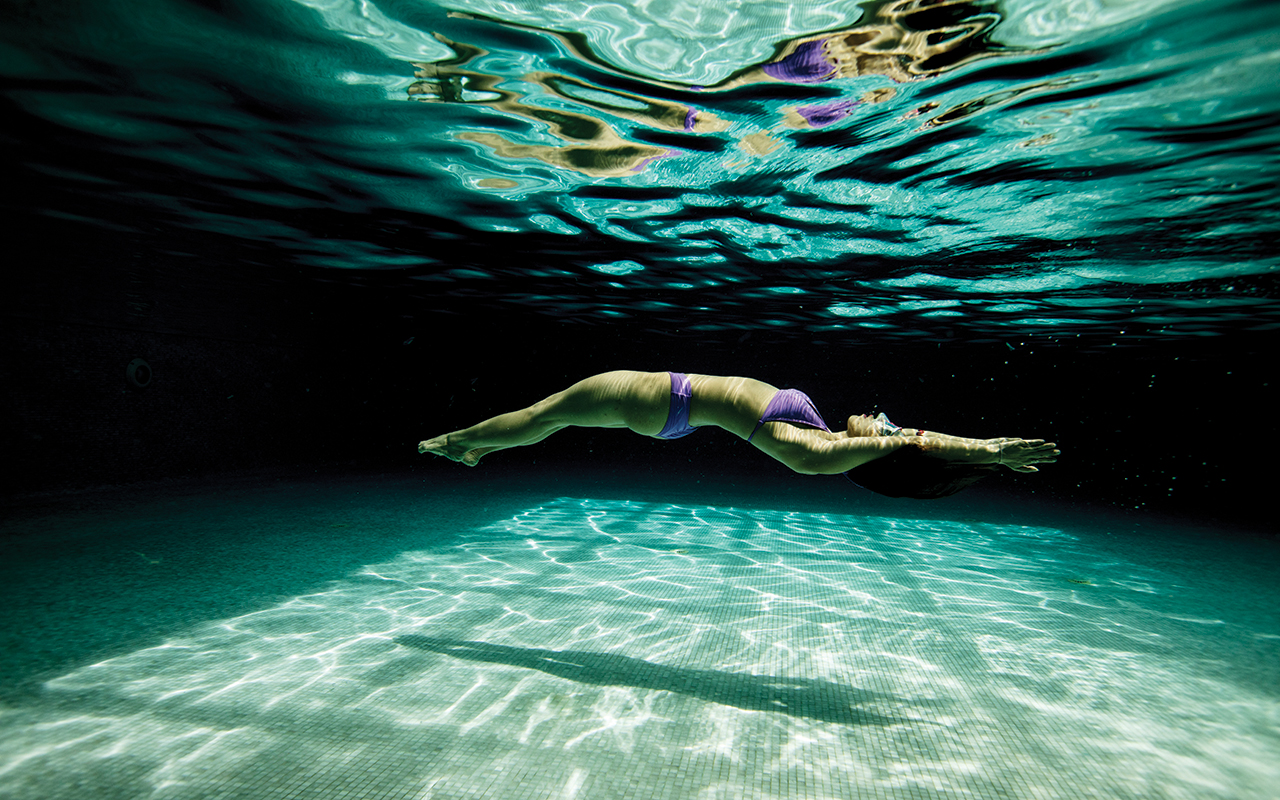I’m no Diana Nyad. But I’m a capable swimmer. During the summer months, I regularly swim a half-mile in the Pacific Ocean, churning through waves and unpredictable tides with the self-assurance of a Los Angeles lifeguard.
So when a gym pal encouraged me to improve my strokes by taking a lesson with Dan Halladay, a retired UCLA women’s swim team coach, I was game. I liked the idea of refining my freestyle, polishing my flip turns, and getting in some intense swim workouts.
As I headed to the pool for my first lesson, I was surprised to feel a pang of nervous tightness in my chest. I met Dan, a fit 68-year-old with a genuine smile, at the far end of a lane reserved for lessons. Dan got down to business quickly, explaining that he’d film my first 50 yards on his iPhone and then get in the water to instruct.
I pulled on my orange swim cap, squared my goggles over my nose, and slipped into the chlorine-scented water. Taking off with purpose, I whirled my arms and kicked my feet at a fast clip. I hit the wall, reversing course with a solid flip turn, and kept pace to finish strongly.
Dan was waiting at the water’s edge. My friend had told me that no matter how good a swimmer I thought I was, Dan would offer corrections. Of course; that’s why I was taking a lesson. But what Dan said surprised me.
Dan relayed the kind of wisdom that transcends sport: “We only have so many starry nights left.”
“Wow, you’re like a wind-up toy in the water,” he joked. Taking a more serious tone, he told me: “Relax. Slow down.” Then, Dan relayed the kind of wisdom that transcends sport: “We only have so many starry nights left.”
The nervous tightness in my chest blossomed. I felt both embarrassed and profoundly seen by Dan’s seemingly obvious observation of my Type A tendencies. The harsh voice of self-criticism rang in my ears: “Why are you trying so hard? You’re not training for the Olympics!”
Then, as it often does when I need it most, my mindfulness practice showed up. I took a deep breath and softened my body. In the space I created between my critical thoughts, waves of self-compassion arose. Pema Chödrön’s sweet refrain of self-acceptance—“allow, allow, allow”—floated into my mind. Reframing my reactivity with kindness, I thought how normal it was for me and for all of us to return to our habitual set points when we try something new, feel stressed, or just get a bad night’s sleep.
Healing the wound of overachieving
And yet, there in the pool my striving was laid bare. Swimming, like many sports, can be an embodied metaphor for how we relate to life. I’ve long equated effort with excellence. More often than not, I’ve made it happen, rather than let it happen. Sometimes there’s merit in that hard-nosed approach. It’s made me successful. But it’s also made me stressed and, at times, woefully unhappy.

Like many people who begin and then develop a lifelong meditation practice, I began meditating as a way to unwind my tightly wound nervous system. It’s worked. Even in times of great difficulty, I’m so much less stressed than I ever have been. The way I muscled myself from one end of the pool to the other, though, told me that the wound of overachieving was still open. It also told me that by taking swim lessons I might have the opportunity to further heal it.
Dan was more than a worthy teacher. In his decades of coaching, he’d trained some of the best collegiate swimmers in the country, teaching them how to efficiently glide through the water at maximum speed.
Swimming, it turns out, is highly paradoxical. Slicing through the water quickly while preserving precious energy requires the perfect muscular balance between laxity and tension. Swim with too much effort and you’ll be gassed before the race is over. Make too little effort and you’ll wallow in the water.
Dan called this razor’s edge of effort “easy speed.”
The feeling of easy speed has returned to me on dry land. It has appeared at times as a welcome companion amid uncertainty, preventing me from regressing into well-worn, stressful habits.
After our brief chat, Dan jumped into the water and stood in front of me in the shallow end. He grabbed my hands and stretched my arms out in front of me, lightly moving them in a rhythmic freestyle motion so I could feel easy speed in my body.
It was a mix of presence, physical ease, and mental relaxation. I knew from other experiences—absorbed concentration during meditation or flow while writing—that the feeling couldn’t be forced. But it could be felt, acknowledged, and trained.
A look of recognition must have registered on my face. Dan smiled. He then explained that instead of ripping and tearing at the water, I needed to extend my arms from my shoulders and reach toward an imaginary pole in front of me that could pull me ahead one stroke at a time.
I made a few fumbling attempts. Dan told me to soften my hands and loosen my fingers, spreading them like Japanese fans. Loose hands meant water could slide more readily past me.
The lesson continued with Dan making numerous corrections and me making numerous bids to embody them. My head was too high in the water. I dropped my right hand before my left hand reached out in front of me. It would be better if I rotated my torso more, and so on.
Dan, though, had me at starry nights. Midway through my lesson, I held my hand up and with the kind of confidence only a recovering overachiever can muster, I told him: “I think I’ve got it.”
I swam the length of the pool, letting my body fall into a state of dynamic relaxation as I concentrated on one or two of Dan’s technical notes. It felt as though I was swimming through peanut butter, barely making headway across the pool. I missed my thrashing and the illusion of control striving bestows.
But when I finished my lap, Dan enthusiastically said: “You won’t believe how fast you were motoring.”
Staying loose in the face of resistance
In the swim lessons since my first, Dan has upped the ante, tethering me to a bungee cord and forcing me to create easy speed against resistance. Life, like swimming, doesn’t always go smoothly or as we plan. So I saw the wisdom of training easy speed in the face of difficulty.
And, in fact, the feeling of easy speed has returned to me on dry land. It has appeared at times as a welcome companion amid uncertainty, preventing me from regressing into well-worn, stressful habits. My striving nature will likely always be a part of me. I’ve become far more accepting of it. At times, I even appreciate it. It’s what drove me to take a swim lesson in the first place. But maybe, sometime in the near future, striving won’t be what propels me forward. Easy speed will be my new set point.
read more
Resilience Expert Offers Three Ways to Tap into the Wisdom of the Body
Linda Graham presents a full toolbox of practices to help you meet the chaos of life with awareness, acceptance, and deep knowledge that you have the strength to work with it all.
Read More
A Quick, Calming Body Scan to Check in With Yourself
Use this fast and easy tool to ground yourself several times a day.
Read More



